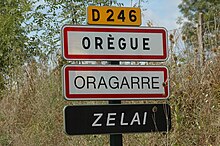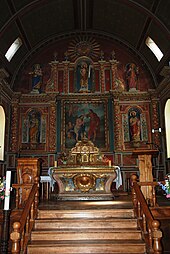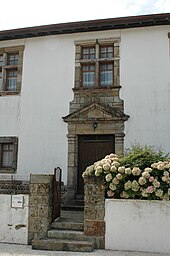Orègue
|
Orègue Oragarre |
||
|---|---|---|
|
|
||
| region | Nouvelle-Aquitaine | |
| Department | Pyrénées-Atlantiques | |
| Arrondissement | Bayonne | |
| Canton | Pays de Bidache, Amikuze et Ostibarre | |
| Community association | Pays Basque | |
| Coordinates | 43 ° 24 ′ N , 1 ° 8 ′ W | |
| height | 19-230 m | |
| surface | 36.43 km 2 | |
| Residents | 485 (January 1, 2017) | |
| Population density | 13 inhabitants / km 2 | |
| Post Code | 64120 | |
| INSEE code | 64425 | |
 Orègue town hall |
||
Orègue is a French municipality with 485 inhabitants (at January 1, 2017) in the department of Pyrénées-Atlantiques in the region Nouvelle-Aquitaine (before 2016: Aquitaine ). The municipality belongs to the Bayonne arrondissement and the canton of Pays de Bidache, Amikuze et Ostibarre (until 2015: canton of Saint-Palais ).
The name of the municipality is Oragarre in the Basque language . The inhabitants are called Oragartar accordingly .
geography
Orègue is located approx. 40 km southeast of Bayonne in the historic Mixe ( Basque Amikuze ) region of the historic Lower Navarra region in the French part of the Basque Country .
Orègue is surrounded by the neighboring communities:
|
Bardos Bidache |
||
|
La Bastide-Clairence Ayherre Isturits |

|
Arraute-Charritte |
| Saint-Martin-d'Arberoue | Méharin | Cupid's succos |
Orègue lies in the catchment area of the Adour River . The Lihoury , a tributary of the Bidouze , crosses the territory of the municipality together with its tributaries,
- the Isaakenbordako Erreka,
- the Sustolako Erreka,
- the Karabindegiko Erreka and its tributary,
- the Otsoerreka,
- the Arbéroue with its tributary,
- the Ruisseau de Jouan de Pès, and
- the Ruisseau Apatharena.
history
The landlord family Oregai gave the community its name. As early as the Middle Ages, the village was under the Oregai, who owned a castle there. But there were also the Tartegarai and Izoste families, who owned at least three houses and a water mill . At the beginning of the Renaissance , these families turned against Jeanne d'Albret , Queen of Navarre, during the Huguenot Wars . They paid for this rebellion by spending their final days in jail.
Toponyms and mentions of Orègue were:
- Sanctus Johannes de Oleger (1160),
- Oreguer (1268),
- Orreguer (1316),
- Oreger (1350),
- Oreguer (1413),
- Oregay (1513, documents from Pamplona ),
- Oregar (1621, after Martin de Viscay),
- Oreguer (1665, Assembly of Estates of Navarre).
- Oregue (1750, 1793 and 1801, map from Cassini , Notice Communale or Bulletin des Lois ) and
- Orègue (1863, Dictionnaire topographique du département des Basses-Pyrénées).
Population development
After a peak of 1070 inhabitants in the middle of the 19th century, the number of inhabitants fell during brief phases of recovery by the 1980s to a level of just under 500 inhabitants, which is still held today.
| year | 1962 | 1968 | 1975 | 1982 | 1990 | 1999 | 2006 | 2009 | 2017 |
|---|---|---|---|---|---|---|---|---|---|
| Residents | 642 | 643 | 671 | 584 | 555 | 544 | 554 | 537 | 485 |
Attractions
Parish Church of Saint-Jean-Baptiste
It is dedicated to John the Baptist . The nave and the chancel were built in the 16th century, the vestibule in the 17th century, as evidenced by the year "1670" above the southern entrance. The porch and the rectangular bell tower were added in the 19th century. The flat apse is high above a semi-underground sacristy .
Inside the church, a gallery consisting of two levels surrounds the single-nave nave on three sides. The pulpit , which was subsequently integrated into the gallery, is unusual . It is made of darker wood and is older than the rest of the gallery. It probably dates from the 18th or 19th century and shows influences from the Gothic and French Classics at the same time . Access to the pulpit is no longer via a separate, traditional staircase as before the construction of the gallery, but rather via this itself.
The church shows three altar retables in the choir around the altar in a complete work, one on the flat rear wall, another one on the side walls. They were made in several stages. In 1710 Jean Dartiguecave was commissioned with the work. Four years later, his brother Bernard was given the gold plating and paintings. At the same time, a local artist, Jean Héguy, made three paintings that define the colors red, blue and green. The baptism of Jesus by John is shown on the main retable in the middle . Statues of Saints Peter and Paul can be seen in a niche to the left and right of the painting. There are other statues on the level above the reredos. John the Baptist can be seen in the middle, flanked by Mary with baby Jesus and a saint with a chalice in his hand, who is probably the apostle John . The curved wooden altar is gilded and painted. It is decorated with a large cartridge in the middle of its front. On it stands the tabernacle , adorned with two bas-reliefs illustrating the Annunciation , and five statuettes of Saints Peter and Paul, two angels and the risen Christ. All three retables have been classified as Monument historique since 2006 .
![]()
The reredos on the left is structured by a frieze with plant scrollwork and cherubins , which is supported by serpentine columns embellished with grapes. A semicircular medallion with a cherub in bas-relief can be seen above the cornice . The altarpiece is of two large volutes with foliage flanked. The central oil painting, measuring 2.05 m in height and 1.48 m in width, shows Mary with the baby Jesus on her lap, who hands over the rosary to St. Dominic , who kneels in front of her . This scene alludes to the missionary work of the Cathars , with which Pope Innocent III. Dominic in the 13th century. In the lower right corner of the picture you can see a dog with a torch to the right of a globe . This motif alludes to a dream of Dominic's mother who, according to legend, had the vision of a dog holding a torch with which he spreads fire over the world. The choice of the motif shows an Iberian artistic influence that goes hand in hand with Dominic's origin from Castile .
Except for the central painting, the reredos on the right is a copy of the work on the left. The oil painting, measuring 2.15 m high and 1.45 m wide, shows Saint Catherine of Alexandria . She steps on the cogwheel of her torture, a crowned male head, presumably the Roman Emperor Maximian , and the sword of her decapitation . The executioner , who still holds the scabbard of the sword in his hand, has fallen to the ground. The saint lifts her gaze to an angel who is holding a crown in the form of a ring above her head. Behind her, a second angel waves flaming lightning.
The church has a lecture cross made of yellow and white gold, which dates from the 17th or 18th century.
Rectory
Based on certain features and its structure, the house probably dates from the 19th century. The entrance is framed by two columns and a neoclassical triangular pediment. The stone window frames also express the 19th century architectural style. Today the house is no longer the pastor's apartment, but guest rooms are offered there.
Orartetxea Castle
In the Middle Ages there was a castle owned by the Oregai family, who gave the municipality its name. Gradually the residence of the rulers took on the name Orartetxea, which was given to the later castle, which was built in the 17th century in the Renaissance style. The present large building with a pink facade and blue shutters houses the historical archives of the community, especially records of the time of the Huguenot Wars, when the noble families rebelled against their Queen Jeanne d'Albret.
Economy and Infrastructure
Agriculture is traditionally the most important economic factor in the municipality. Mainly corn is grown and cattle are raised. Orègue is located in the AOC areas of Ossau-Iraty , a traditionally made semi-hard cheese made from sheep's milk, as well as the pig breed and the ham "Kintoa".

total = 58
sport and freetime
A circular path on foot or by bike with a length of 8 km and a difference in altitude of 160 m leads from the Laharanne district of the municipality over hills and forests.
traffic
Orègue can be reached via routes départementales 123, 156, 246 and 318.
Personalities
- Jean Errecart, born on July 12, 1909 in Orègue, died on January 17, 1971 in Paris , was a French politician and u. a. Representative of the canton of Saint-Palais in the General Council of the Department from 1945 to 1971.
- Itxaro Borda, or Bernadette Borda, born on March 29, 1959 in Bayonne, is an author of short stories, novels, poems and essays in the Basque language. Her family is originally from Orègue.
Web links
- Website of the AOP Ossau-Iraty association (French)
- Filière Porc Basque website (French)
Individual evidence
- ↑ Lieux - toponymie: Oragarre (Amikuze) ( fr ) euskaltzaindia . Retrieved October 18, 2017.
- ↑ Ma commune: Orègue ( fr ) Système d'Information sur l'Eau du Bassin Adour Garonne. Retrieved October 18, 2017.
- ↑ a b Orègue ( fr ) visites.aquitaine.fr. Archived from the original on October 19, 2017. Info: The archive link was automatically inserted and has not yet been checked. Please check the original and archive link according to the instructions and then remove this notice. Retrieved October 18, 2017.
- ^ Jean-Baptiste Orpustan: Nouvelle toponymie basque ( fr ) University of Bordeaux . S. 82. 2006. Retrieved October 18, 2017.
- ^ Paul Raymond: Dictionnaire topographique du département des Basses-Pyrénées ( fr ) In: Dictionnaire topographique de la France . Imprimerie nationale. P. 126, 1863. Retrieved October 18, 2017.
- ^ David Rumsey Historical Map Collection France 1750 ( en ) David Rumsey Map Collection: Cartography Associates. Retrieved October 18, 2017.
- ↑ a b Notice Communale Orègue ( fr ) EHESS . Retrieved October 18, 2017.
- ↑ Populations légales 2006 Commune d'Orègue (64425) ( fr ) INSEE . Retrieved October 18, 2017.
- ↑ Populations légales 2014 Commune d'Orègue (64425) ( fr ) INSEE . Retrieved October 18, 2017.
- ↑ Église Saint-Jean-Baptiste ( fr ) visites.aquitaine.fr. Archived from the original on October 19, 2017. Info: The archive link was automatically inserted and has not yet been checked. Please check the original and archive link according to the instructions and then remove this notice. Retrieved October 18, 2017.
- ^ Eglise paroissiale Saint-Jean-Baptiste ( fr ) Ministry of Culture and Communication . Retrieved October 18, 2017.
- ↑ Galeries de l'église Saint-Jean-Baptiste ( fr ) visites.aquitaine.fr. Archived from the original on October 19, 2017. Info: The archive link was automatically inserted and has not yet been checked. Please check the original and archive link according to the instructions and then remove this notice. Retrieved October 18, 2017.
- ↑ Chaire à prêcher de l'église Saint-Jean-Baptiste ( fr ) visites.aquitaine.fr. Archived from the original on October 19, 2017. Info: The archive link was automatically inserted and has not yet been checked. Please check the original and archive link according to the instructions and then remove this notice. Retrieved October 18, 2017.
- ↑ Retable de l'église Saint-Jean-Baptiste ( fr ) visites.aquitaine.fr. Archived from the original on October 19, 2017. Info: The archive link was automatically inserted and has not yet been checked. Please check the original and archive link according to the instructions and then remove this notice. Retrieved October 18, 2017.
- ↑ maître-autel, retable, tableau: Le Baptême du Christ, 5 statues: saint Pierre, saint Paul, Vierge à l'Enfant, saint Jean-Baptiste, saint Jean (?) ( Fr ) Ministry of Culture and Communication . Retrieved October 18, 2017.
- ↑ Tableau de saint Dominique ( fr ) visites.aquitaine.fr. Archived from the original on October 19, 2017. Info: The archive link was automatically inserted and has not yet been checked. Please check the original and archive link according to the instructions and then remove this notice. Retrieved October 18, 2017.
- ↑ retable, tableau: Saint Dominique recevant le rosaire des mains de la Vierge ( fr ) Ministry of Culture and Communication . Retrieved October 18, 2017.
- ^ Tableau de sainte Catherine d'Alexandrie ( fr ) visites.aquitaine.fr. Archived from the original on October 19, 2017. Info: The archive link was automatically inserted and has not yet been checked. Please check the original and archive link according to the instructions and then remove this notice. Retrieved October 18, 2017.
- ^ Retable, tableau: Sainte Catherine d'Alexandrie ( fr ) Ministry of Culture and Communication . Retrieved October 18, 2017.
- ↑ Croix de procession de l'église Saint-Jean-Baptiste ( fr ) visites.aquitaine.fr. Archived from the original on October 19, 2017. Info: The archive link was automatically inserted and has not yet been checked. Please check the original and archive link according to the instructions and then remove this notice. Retrieved October 18, 2017.
- ↑ Presbytère d'Orègue ( fr ) visites.aquitaine.fr. Archived from the original on October 19, 2017. Info: The archive link was automatically inserted and has not yet been checked. Please check the original and archive link according to the instructions and then remove this notice. Retrieved October 18, 2017.
- ↑ Château d'Orartetxea ( fr ) visites.aquitaine.fr. Archived from the original on October 19, 2017. Info: The archive link was automatically inserted and has not yet been checked. Please check the original and archive link according to the instructions and then remove this notice. Retrieved October 18, 2017.
- ↑ Institut national de l'origine et de la qualité: Rechercher-un-produit ( fr ) Institut national de l'origine et de la qualité . Retrieved October 18, 2017.
- ↑ Caractéristiques des établissements en 2015 Commune d'Orègue (64425) ( fr ) INSEE . Retrieved October 18, 2017.
- ↑ Circuit pédestre Haitze à Oregue ( fr ) Office de tourisme de Basse Navarre. Retrieved October 18, 2017.










